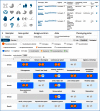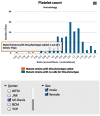A mouse informatics platform for phenotypic and translational discovery
- PMID: 26314589
- PMCID: PMC4602054
- DOI: 10.1007/s00335-015-9599-2
A mouse informatics platform for phenotypic and translational discovery
Abstract
The International Mouse Phenotyping Consortium (IMPC) is providing the world's first functional catalogue of a mammalian genome by characterising a knockout mouse strain for every gene. A robust and highly structured informatics platform has been developed to systematically collate, analyse and disseminate the data produced by the IMPC. As the first phase of the project, in which 5000 new knockout strains are being broadly phenotyped, nears completion, the informatics platform is extending and adapting to support the increasing volume and complexity of the data produced as well as addressing a large volume of users and emerging user groups. An intuitive interface helps researchers explore IMPC data by giving overviews and the ability to find and visualise data that support a phenotype assertion. Dedicated disease pages allow researchers to find new mouse models of human diseases, and novel viewers provide high-resolution images of embryonic and adult dysmorphologies. With each monthly release, the informatics platform will continue to evolve to support the increased data volume and to maintain its position as the primary route of access to IMPC data and as an invaluable resource for clinical and non-clinical researchers.
Figures






References
Publication types
MeSH terms
Grants and funding
LinkOut - more resources
Full Text Sources
Other Literature Sources
Research Materials

